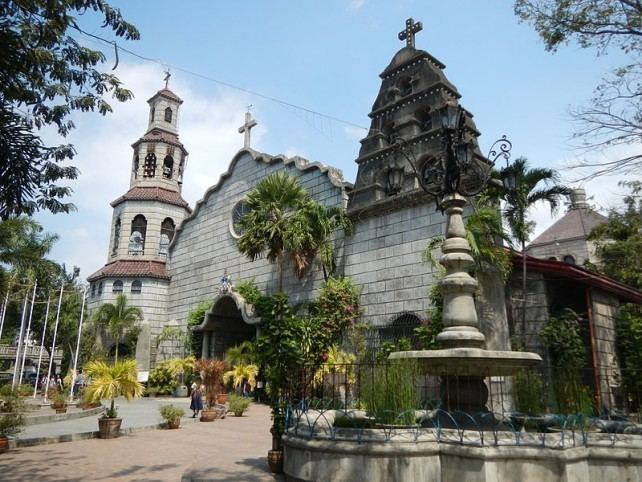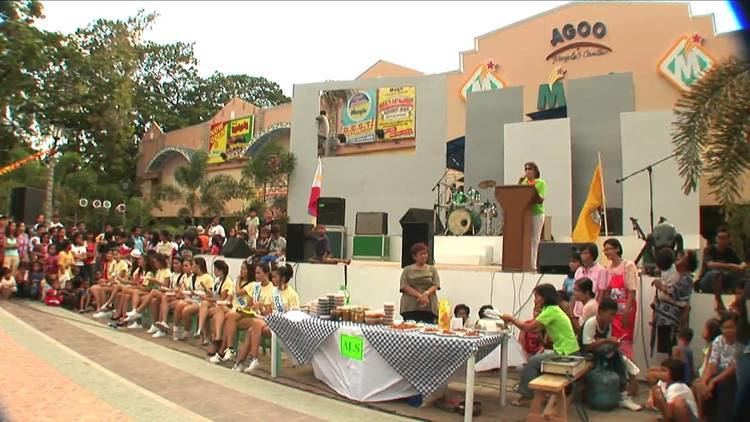Country Philippines Region Ilocos Founded 1578 | Area 52.84 km2 District 2nd District Mayor Sandra Y. Eriguel | |
 | ||
Map of Agoo
Agoo (Ilocano: Ili ti Agoo), officially the Municipality of Agoo, is a 1st class municipality in the province of La Union, Philippines. According to the 2015 census, it has a population of 63,692 people.
Contents
- Map of Agoo
- Agoo ecofun world
- Green team agoo la union
- History
- Before the Spanish
- Sighting by Juan de Salcedo
- Development by the Augustinians
- Integration into La Union
- Japanese Invasion of Lingayen Gulf
- Establishment of the South Provincial High School and the Don Mariano Marcos Memorial State University
- Alleged Marian Apparitions
- Election and Drug Related Violence 2010 Present
- New city proposed in merger of Agoo and Aringay
- Demographics
- Local government
- Elected Officials
- Tourism
- Cultural and Architectural Attractions
- Nature Attractions
- Festivals
- Other Attractions
- Notable people
- References
Its name is usually attributed to "aroo" or "agoho," a pine-like evergreen tree (Casuarina equisetifolia or Whistling Pine) that thrived in the western coast during the pre-Spanish Period.

Agoo ecofun world
Green team agoo la union
History

Agoo's administrative dates back further than most Philippine municipalities, with the town being established within the same decade that the Spanish colonizers arrived on the Island of Luzon. The history of the settlement now known as Agoo dates back even further, with both documentary and artifactual evidence supporting the assertion that it was a major port of call for foreign traders before it was formally established by the Spaniards.
Before the Spanish
Before the province of La Union was established, Agoo was part of Pangasinan, and was a settlement of people of the "same race as those of Pangasinan." These people traded with Chinese merchants long before Columbus even sailed to the new world, as shown by the porcelain and pottery excavated from the site of the Catholic church during its renovation - now kept in the Museo de Iloko.
Later, the Japanese came and established their first settlement in the Philippines. At this time, Agoo's coast was shaped in such a way that it was a good harbor for foreign vessels coming into Lingayen Gulf. Miguel De Loarca referred to Agoo as “El Puerto de Japon” - the Japanese Port.
Rosario Mendoza-Cortes, in her book "Pangasinan 1572-1800" suggested that Agoo was likeliest to be the region's primary port of call for Japanese and Chinese traders - the only other candidate being Sual, Pangasinan. This was because there was a Japanese colony there, because traders at Agoo would have access to a greater number of people, and it was nearer to China and Japan. The main product traded from the area was deer pelt, which was shipped to Japan.
Agoo's role as a port deteriorated when the Spanish closed the Philippines to foreign trade. When foreign trade was allowed again, it was Sual that became the dominant port.
Sighting by Juan de Salcedo
In 1572, Juan de Salcedo, fresh from his conquest of Southern Luzon, was ordered by Miguel Lopez de Legazpi to explore Northern Luzon and “pacify the people in it”.
In June 1572, he was traversing the Angalakan River, when he saw and attacked three Japanese ships. When they fled, Salcedo followed them until they landed at a Japanese settlement. After paying tributes, the Japanese were allowed to remain. These Japanese would leave when the port of Agoo was later closed, but not without first teaching the natives their methods of fish culture, rice cultivation, deerskin tanning, duck breeding, and weapons manufacturing.
A permanent settlement was established in Agoo in 1578 when two Franciscan Missionaries, Fray Juan Bautista Lucarelli of Italy and Fray Sebastian de Baeza of Spain, constructed a thatch and bamboo church in honor of Saint Francis of Assisi. Agoo encompassed a vast land area that spanned the modern day towns of Rosario, Santo Tomas, Tubao, Pugo, Aringay, Caba, Bauang and the a place called "Atuley" or present day-San Juan. Agoo became the center of the campaign of pacification and conquest, not only of the surrounding towns that would later become La Union, but of the mountain tribes in the Cordilleras as well.
The two missionaries formally proclaimed Agoo as a civic unit. naming it after the river along whose banks it was built. At the time, the riverbank was forested with pine-like trees locally called "aroo" or "agoho" (Casuarina equisetifolia, or Whistling Pine).
In another claim of the town's origin, Agoo was said to be derived from a variety of flying fish (chileopogon agoo) by which the Japanese settlers called it thereafter.
Development by the Augustinians
Most of the town's early development can be attributed to the efforts of the Augustinian Order. They took over from the Franciscans and administered the town off and on throughout the Spanish occupation until the secular priests took over in 1898.
They changed the town's patron saint to Santa Monica. They established a school where reading, writing, industrial works, and catechism were taught. They relocated the town center, laid out the streets and public buildings, and established roads leading to the nearby towns.
To facilitate the construction of churches, public buildings and bridges, they taught the people brick and lime making, brick-laying, and stone-quarrying. They introduced the “moro-moro”, the singing of “pasyon”, new farm implement and new plants.
Father Aquilino Garcia constructed a church, and by the end of the 15th century the image of Nuestra Señora de Caridad (Our Lady of Charity) was installed in it. This church was destroyed in 1796 and a new one was built when the original settlement was moved to what has ever since been the town center. The church was then claimed to be the largest and grandest in northern Luzon during that time. Ruins are scattered althroughout the town's center and some are visible at this point of time.
Integration into La Union
On March 2, 1850, the province of La Union was created by Governor–General Antonio Maria Blanco. It comprised the north-western towns of Pangasinan and the towns of Ilocos Sur south of the Amburayan river. Agoo was the oldest town to be integrated and was listed as having a population of 6,936 people.
Japanese Invasion of Lingayen Gulf
In the early morning of 22 December 1941, Agoo was one of several beachheads taken by the invasion force of General Masaharu Homma during the Japanese Invasion of Lingayen Gulf and became one of the Japanese staging points for the Battle of Rosario.
Establishment of the South Provincial High School and the Don Mariano Marcos Memorial State University
On July 23, 1945 the Municipal government, then led by Mayor Miguel Fontanilla, established South Provincial High School in response to education-oriented citizen Ramon Mabutas' calls for the establishment of a public high school. South Provincial High School turned Agoo into a center of education for Southern La Union, and became one of the constituent state-run schools that were combined by Presidential Decree 1778 in order to create the Don Mariano Marcos Memorial State University in 1981.
Alleged Marian Apparitions
The town came into focus for the alleged Marian apparitions of the Blessed Virgin Mary to Judiel Nieva. Nieva reported seeing the Virgin Mary, popularly known as Our Lady of Agoo atop a Guava tree, a statue weeping with blood became highly sensationalized. Religious pilgrimages among Filipino Catholics increased by the millions as people flocked to see the phenomenon. The alleged apparition and healing events came into the attention of the Catholic Bishops' Conference of the Philippines, who in turn began an investigation and later released an ecclesiastical ruling that the apparitions were non-supernatural in origin in 1993.
Election and Drug Related Violence (2010-Present)
Since 2010, either the Municipality Agoo has been regularly declared an election hotspot due to incidences of violence during national and local election periods. Major incidents include the murder of former Tubao Vice Mayor Lazaro Gayo outside his law office near Agoo's Municipal Hall, and an alleged assassination attempt on Tubao Mayor Dante Garcia in the same year; and an alleged assassination attempt on former Congressman Eufranio Eriguel in 2016.
Media attributed the violence to "intense rivalry" between incumbent Congressman Eufranio Eriguel and his 2010 opposing candidate, former Rep. Thomas Dumpit Jr., and later to "clashes between the followers" of Congressman Eriguel and his 2013 opponent, former Army General Mario Chan.
In 2013, the declaration of the towns Tubao, Agoo, Caba, and Aringay as election hotspots compelled the Philippine National Police to temporarily remove the police chiefs of the four towns during the election period, a decision which was protested by incumbent politicians in both towns, including then-Congressman Eriguel and his wife, then-Mayor Sandra Eriguel.
Also during the 2010s, a number of drug-related incidents in Agoo came to national attention. This resulted in the sacking of the police chief of Agoo, along with those of the Southern La Union towns of Bauang, Naguilan, and Tubao.
On August 16, 2016, former Congressman Eriguel was included by Philippine President Rodrigo Duterte as one of the local government officials and legislators allegedly involved in illegal drug trade in his "I am sorry for my country" speech. Eriguel and a number of other Southern La Union politicians denied these allegations.
New city proposed in merger of Agoo and Aringay
On June 11, 2014 then-representative Eufranio Eriguel filed House Bill 4644 to establish the first city in the second district by merging the municipalities of Agoo and Aringay. The bill was co-authored by La Union first district Rep. Victor Ortega and Abono party-list Rep. Francisco Emmanuelle Ortega III, and was deemed necessary because neither Aringay nor Agoo alone could meet the requirements to create a Philippine city: a population of 150,000; an annual income of P100 million minimum a year; and a land area of 100 square kilometers. (As of 2014, the national census showed that Agoo and Aringay have about 65,000 and 47,500 residents, respectively. Agoo posted more than P90 million, and Aringay made P15,000 million in annual earnings, respectively)
The proposed city would have two districts under a city mayor and city vice mayor along with 14 councilors in the Sangguniang Panlungsod, new positions for which the former municipal officials could run despite having the terms limits of their offices.
The proposed bill sparked protests from the people of Aringay who did not want the merger with Agoo because it would subject them to the same high local taxes as Agoo, and because of concerns that Aringay would lose its cultural identity. The proposed merger did not push through within term of the 16th congress.
Demographics
In the 2015 census, the population of Agoo was 63,692 people, with a density of 1,200 inhabitants per square kilometre or 3,100 inhabitants per square mile.
Local government
Just as the national government, the municipal government of Agoo, is divided into three branches: executive, legislative and judiciary. The judicial branch is administered solely by the Supreme Court of the Philippines. The LGUs have control of the executive and legislative branch.
The executive branch is composed of the mayor and the barangay captain for the barangays.Local Government Code of the Philippines, Book III, Department of Interior and Local Government official website.
The legislative branch is composed of the Sangguniang Bayan (town assembly), Sangguniang Barangay (barangay council), and the Sangguniang Kabataan for the youth sector.
The seat of Government is vested upon the Mayor and other elected officers who hold office at the Town hall. The Sanguniang Bayan is the center of legislation, stationed in Agoo Municipio.
Elected Officials
Tourism
Agoo has interesting attractions and main festival/events:
